Hello community, I joined the truenas community about a year ago, my server configurations are:
Truenas Scale: Dragonfish-24.04.2
Processor: Xeon E5-2690 v4
Memory: 128Gb ECC
Motherboard: X99-QD4
1 Pool Mirror: 2x1Tb(NVME KingSpec),
1 Pool Mirror: 2x 3Tb (WD Red),
1 Pool Stripe: 2x7Tb (IronWolf),
1x6Tb (USB Seagate EDD),
1x3Tb (WD Red),
1x1Tb (Samsung),
1x1Tb(USB WD)
I am aware that stripe is not a recommended configuration, but I do not store anything of utmost importance in the stripe pool, only movies and series, which I can download again, but unfortunately I put a 1 Tb disk in it, which caused this problem I believe, after I restarted the server the stripe pool appears as if some disks in the pool had been exported, I tried to perform some procedures in the forum, and I only receive this message.

So I exported the pool definitively through the truenas UI, and tried to run the same procedures, and I get the same error message.
I ran smartctl on all disks in the pool, only the 1tb disk showed a pending bad sector.
Can anyone tell me if I have any chance of recovery? I have no problem losing the data, I just didn’t want to download everything again.
Sample of the commands executed
zpool import

zpool import -f -F -m

zpool import -fFX
It takes a long time to execute, I left it for 3 days and it didn’t finish
zpool status -v
I left it for about 6 hours and it didn’t finish
zpool import -f -F -n
It doesn’t show any return
zpool import -f -F -R /mnt

I tried to perform the import through the truenas UI is:
